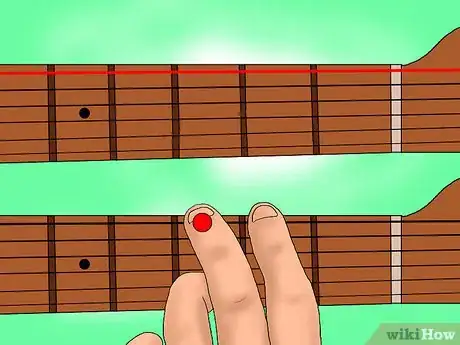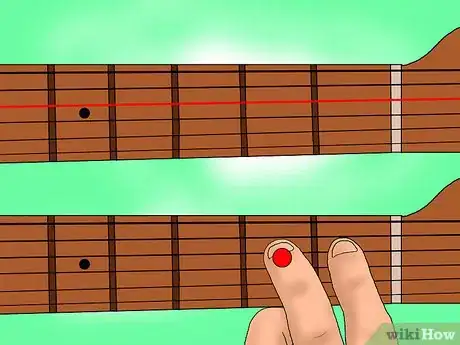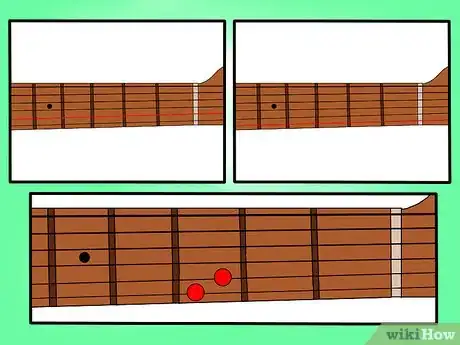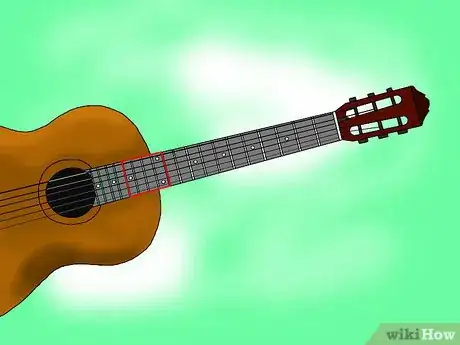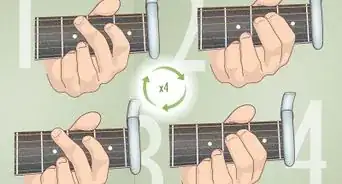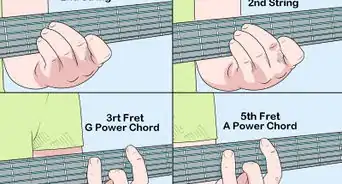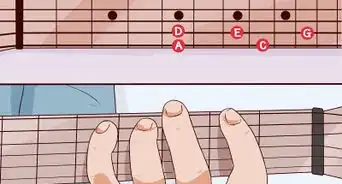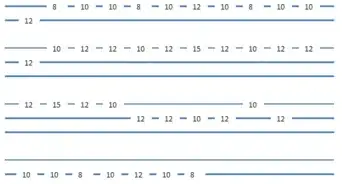This article was co-authored by Carlos Alonzo Rivera, MA. Carlos Alonzo Rivera is a guitarist, composer, and educator based in San Francisco, California. He holds a Bachelor of Arts degree in Music from California State University, Chico, as well as a Master of Music degree in Classical Guitar Performance from the San Francisco Conservatory of Music. Carlos specializes in the following genres: classical, jazz. rock, metal and blues.
This article has been viewed 33,322 times.
The Blues, a type of music originating from the African-American communities in the Deep South of the United States at the end of the 19th century from spirituals, work songs, field hollers, shouts and chants, and rhymed simple narrative ballads. As a musical form, it began and developed with little more than guitars and voices. While the blues take a lifetime to develop, the basics are simple enough for anyone to begin playing.
Steps
Playing the 12-Bar Blues Chords
-
1Use the 12-bar blues chord progression as the backing of any blues song. This form is simply a guide for when to play certain chords. Each bar (or count of "1,2,3,4, 1,2,3,4, 1...") is assigned a chord, and together they form the melodic backbone of 95% of blues songs. To make it, you simply take the first (I), fourth (IV), and fifth (V) chords of the major scale and make them into chords. Once you know the form in one key, like "E," you can then easily transpose the song into any key you want. For the key of E, your chords are E, A, and B.
- While the following article uses easy to form power chords, you can also uses seventh chords, minor chords, or minor sevenths.
- Before beginning, make sure you review the major and minor scales for guitar.
- The blues are in simple 4/4 time, like almost all radio songs. If this is a struggle, review rhythm and time signatures.
-
2Alternate a big downstroke and a quick upstroke when strumming for a "shuffle" feel. Use a "swung", chugging rhythm to give the song a blues feel — your strums should sound like "dun da-dun da-dun da-dun..." It can help to listen to early blues recordings like Robert Johnson's "I Believe I'll Dust My Broom" to get this rhythm down.br>
- If you count out, like "1 and, 2 and, etc," think of a big strum down on the number, then a quick upstroke for "and."
- If this is difficult at first, start with a strumming pattern that works for you until you get the progression down.
Advertisement -
3Play an open E, the I chord, for four measures. The first chord you play is going to be the key of the song. If you start with an E, your songs will be a twelve bar blues in the key of E. You will hold this E for four full bars.
- It always helps to practice with a metronome to ensure you play each measure the correct number of times.
-
4Play open A (the IV chord) for two measures, return to then E for two measures. Next, in a 12-bar blues, you play the fourth of the starting chord for two measures before returning to the starting chord. Since A is three notes above an E in the major scale, it's the IV chord in the key of E.
-
5Play B-A-E-B, each for one measure to end the progression. The last four bars of a 12-bar blues are called the turnaround. In the turnaround, you play the fifth, the fourth, the starting chord, and then repeat the fifth one more time. B is the fifth of E since it is one note above A, the fourth, so we play B, then A, then E, then B again.EXPERT TIPCarlos Alonzo Rivera is a guitarist, composer, and educator based in San Francisco, California. He holds a Bachelor of Arts degree in Music from California State University, Chico, as well as a Master of Music degree in Classical Guitar Performance from the San Francisco Conservatory of Music. Carlos specializes in the following genres: classical, jazz. rock, metal and blues.Professional Guitarist

 Carlos Alonzo Rivera, MA
Carlos Alonzo Rivera, MA
Professional GuitaristPro Tip: "The one, four, and five chord can all be turned into what's known as a dominant seventh chord in blues. So if you're going to play blues in the key of E major, you can substitute E, A and B for E7, A7 and B7." Try this out and compare the sounds of the different progressions!
-
6Repeat ad nauseum. That's all there is to a basic 12-bar blues — just play E-E-E-E-A-A-E-E-B-A-E-B until the song's over (note that, when they're performed live, most 12-bars have a special ending that will vary from song to song.) To get the full 12-bar experience, try getting a friend who's more experienced at guitar to solo over your chords — with a little practice, you should soon get the hang of this simple but important blues progression.
- To play in a different key, simply pick a different starting chord and shift the fourth and fifth accordingly. For instance, if you want to play in the key of C, you'll use C as your starting chord, F for the fourth, and G for the fifth.
- Looking to spice up your progression? Check out Wikihow's ways to spice up your riff.
-
7Substitute 7 chords for a bluesy feel. Real blues musicians often use a special kind of chord called a "7" chord (or a "dominant 7th chord") to make the song sound a little "bluesier." These chords are the same as major chords, but with one note different. For a quick rundown of how to finger the most common 7 chords, click here.
- You have two options when you substitute 7 chords into a 12-bar blues: you can either change the fifth to a 7 chord (for instance, in the key of A, E would become E7), or you can change every chord to a 7 chord (in the key of A, A would become A7, D would become D7, and E would become E7.) Different options sound better for different songs, so try experimenting to find the chords you like.[1]
Learning the Basic Blues Scale
-
1Use a modified version of the pentatonic scale to solo over any chord progression. If you remember the pentatonic scale, this will be an easy modification. If you don't know it, then it can't hurt to review, but the rest of the article will continue as if you've never played it before.
- The following scale is for the E-minor blues, meaning it will fit the chord progression played earlier.
-
2Use all of the open strings as part of your scale. The beauty of playing in E is that you can use all of the open notes as part of your scale, meaning you don't have to fret six of the notes in the scale. This can make hammer-ons, pull-offs, and quick multi-string playing a lot of fun with a lot less effort.
-
3Play the open note and the 3rd fret on the sixth string. These are the first two notes of your scale. Play the root note, here the E on the open sixth string, then move down three frets. Most people play this second note with their ring finger or pinky.
- Remember that the pentatonic scale is a "shape." You can move this to start on any note on the 6th string. The first note of the scale will be the song's key.
-
4Move down a string, playing the open note, the first fret, and the second fret. These three notes are where the blues scale differs from the pentatonic, which ignores the first fret. This note, however, is the "flat fifth" in music theory that makes a song sound bluesy. You will play three notes total on the A string.
- The flat fifth is an accent -- it is best played quickly, not lingered on.
-
5Play the open string and second fret on the D string. Note how a box-like pattern is forming. The open strings form a constant "line" of notes in the scale, while your ring finger frets a box either 2-3 frets down. Here, you simply play the open string and the second fret.
-
6Play the open string, second fret, and third fret on the G string. This third fret is actually a reoccurring flat fifth -- it is the octave of the note you played earlier. Theory aside, this means the 3rd fret, usually played with your pinky, is another bluesy accent note.
-
7Play the open string and the 3rd fret of the last two strings. The last two strings are identical to the first string. Simply create this little box between the open string and the third frets on both the high-E and B strings.
-
8Move the whole scale down to the 12th fret to see how easily the form moves. You can play the exact same scale starting from a different E. Simply move the whole form down to the 12th fret, since the 6th string 12th fret note is another E. Now, instead of playing open notes, you simply fret every string on the 12th fret when you get to it. Everything else stays in place.
- Now that you know the scale, practice getting up and down it as smoothly and quickly as possible, in multiple locations across the fret board.
- Check out "Master Lead Guitar Basics" for cool ways to use notes in a solo or improvisation.[2]
Things You'll Need
- A guitar (if electric, use amp if available)
- A plectrum (or thumb if you don't have one)
- A fair knowledge of guitar
References
About This Article
To play the blues on the guitar, start by playing an open E chord for 4 measures while alternating a big downstroke with a quick upstroke. Continue this rhythm as you play an open A chord for 2 measures before returning to the E chord for another 2 measures. For the next 4 bars, play the fifth, the fourth, and the starting chord, before returning to the fifth chord one more time. Then, repeat this pattern throughout the song. If you want a more bluesy feel, consider substituting a “7” chord for some of the chords in the song. For tips from our Music co-author on how to play a basic blues scale, read on!
